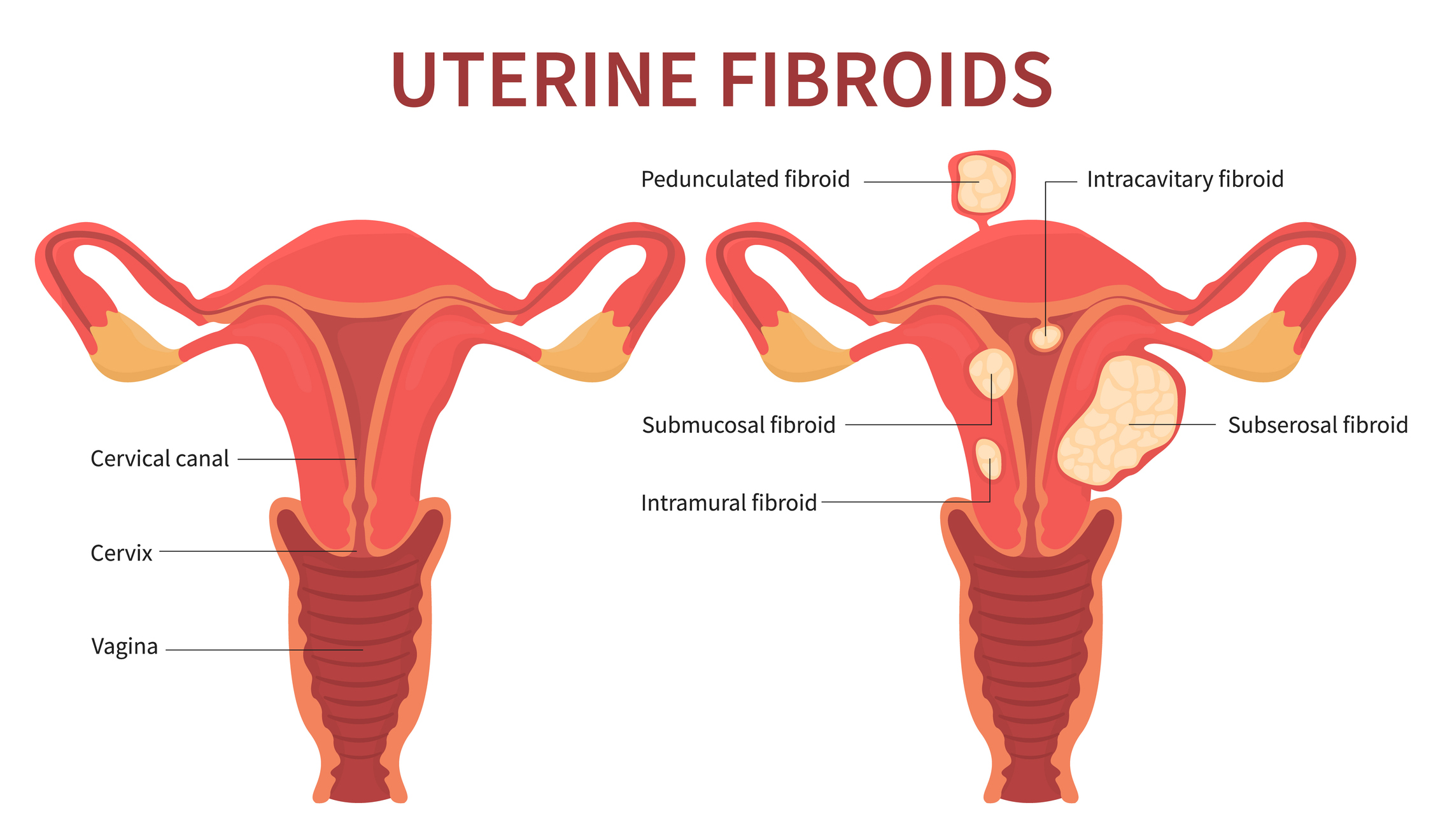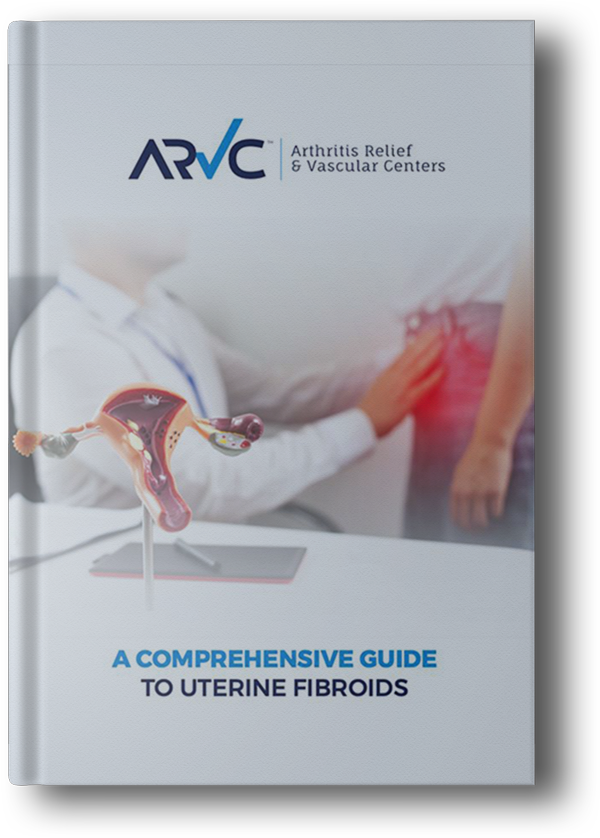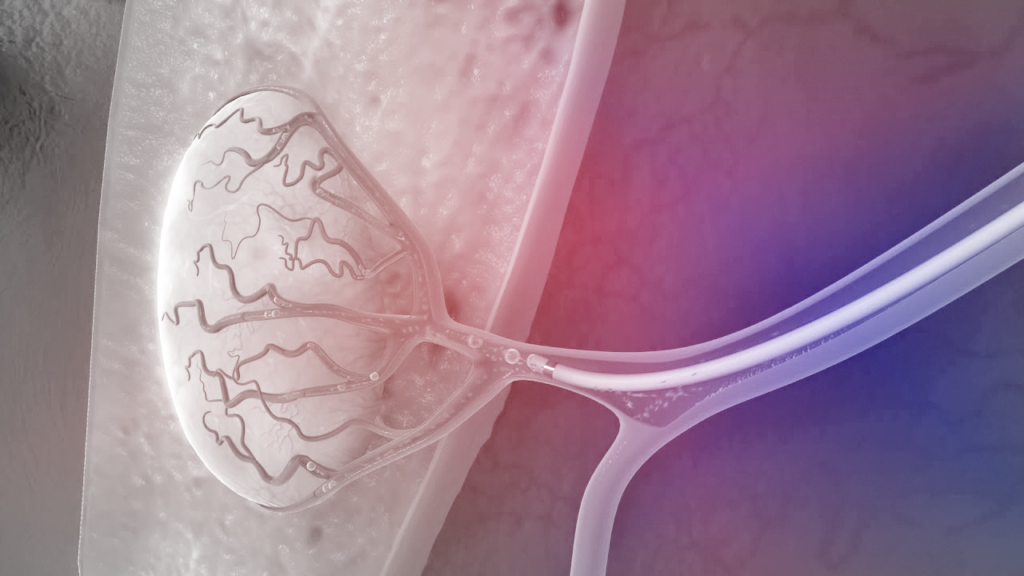Uterine Fibroid Embolization (UFE) is an FDA-Approved, Safe and Effective Alternative to Surgery for Uterine Fibroids
Through a tiny pinhole incision in the groin, our Interventional Radiologists guide a catheter to the arteries supplying the fibroids. Tiny particles are injected to block these blood vessels, causing the fibroids to shrink and die and the symptoms to subside.
What Are Uterine Fibroids?
Uterine fibroids are non-cancerous growths that develop within the muscular wall of the uterus. They are a common issue, affecting up to 70-80% of women during their reproductive years. Fibroids can cause a variety of symptoms including:
- Heavy or prolonged menstrual bleeding
- Blood clots
- Irregular/unpredictable menstrual cycles
- Pelvic pain/pressure and cramps
- Frequent urination
- Constipation
- Abdominal distention/bloating
- Fatigue
- Anemia due to heavy bleeding
- Painful sexual intercourse
- Back pain or leg pain
- Infertility

Established Risk Factors For Developing Fibroids
- Age: Fibroids are most common in women in their 30s and 40s, and the risk increases with age during the reproductive years. They tend to shrink after menopause.
- Race: African American women are at a significantly higher risk of developing fibroids. They may develop them earlier, and the fibroids tend to be larger and more symptomatic.
- Family History: If your mother, sister, or other close relatives have had fibroids, your risk is 300% increased.
- Obesity: Women with a high body mass index (BMI) are more likely to develop fibroids.
- Early Onset of Menstruation: Starting your period at a young age may be associated with an increased risk.
- Pregnancy: No prior history of pregnancy increases risk for fibroids.
Potential Risk Factors For Fibroids
Important Note
FEATURED RESOURCE - FREE E-BOOK
Understanding Uterine Fibroids & UFE (Uterine Fibroid Embolization)

UFE at ARVCenters: Your Partner in Fibroid Care
At ARV Centers, our experienced Interventional Radiology team are dedicated to providing personalized care and the most advanced UFE treatment available. We understand the impact fibroids can have on your life, and we’re here to help you find relief.
Don’t let fibroids control your life. Contact ARVC today to schedule a free consultation and learn more about how UFE can help you reclaim your well-being with an unnecessary surgery.
UTERINE FIBROID EMBOLIZATION PROVIDES A HOST OF ADVANTAGES COMPARED TO HYSTERECTOMY:
Why Choose UFE over Hysterectomy?
-
Less Risk
UFE is a minimally invasive procedure with
significantly lower risks compared to major surgery. -
Faster Recovery
Recover in the comfort of your own home, typically
within a few days to a week without any hospitalizations. -
Non-Surgical
Avoid the risks, scarring, and longer recovery
associated with surgery.
-
Covered by Insurance
Most insurance plans cover UFE, making it a an easy and affordable treatment option. -
FDA-Approved
UFE is a safe and well-established procedure
approved by the FDA for more than 25 years. -
Minimal Downtime
Get back to your life faster with UFE. Resume full physical activity to tolerance 48 hours after treatment.
Life After UFE: Inspiring Patient Stories
Putting Patients First: Hear Their UFE Experiences
Key Benefits of UFE at ARVCenters:
- Minimally Invasive Office Procedure
- Uterine Sparing
- Fast Recovery: Back to work in as few as 3-5 days
- Proven Results (Over a 90% Success Rate)
- Expert Care
- No scarring
- No stitching
- Low risk
- Personalized
Treatment Plans

FAQs: Frequently Asked Questions About Uterine Fibroid Embolization (UFE)
UFE may be an excellent option for women who:
- Have symptomatic fibroids.
- Have no single fibroids more than 20 cm in size.
- Have no history of active uterine, cervical or ovarian cancer.
- Want to avoid surgery and keep their uterus.
- Still planning for a family.
- Don’t want to undergo a long painful recovery.
- Can’t afford the downtime of taking off work for a long recovery.
- Prefer to avoid the risks of a major surgery like hysterectomy.
Best Analogies for Different Patients
For Visual Learners:
For Tech-Minded Patients:
For Practical Thinkers:
For Detail-Oriented Patients:
Without oxygen and nutrients from the blood, fibroids cannot survive, causing them to shrink and die.
- The procedure takes place in our office in our Radiology Suite, which is similar to an operating room.
- The procedure takes approximately 60-90 minutes and is not painful.
- You are given IV sedation known as “twilight” sedation to help you relax.
- During the procedure you will not be in any pain. The only discomfort for the entire treatment is numbing the skin at the top of your thigh with a small needle before we gain access to the blood vessel. This feels like a “pinch and a burn” for a few seconds.
- Most patients are discharged within 1 hour from the time the procedure is completed.
- You will be given pain medications intravenously before you leave and given a Rx for pain medications, anti-nausea medications and a stool softener to take at home.
- For 12-24 hours after the procedure, you can expect to feel uterine cramping similar to a bad menstrual cycle. The medications we prescribe helps ease the pain the first day after the procedure.
- Most women are back to normal activities after 48 hours, but it is common to feel some fatigue and abdominal bloating for up to a week.
- Spotting is common for 2-4 weeks post procedure.
- Most women return to work within 3-5 days of the procedure. If women have many fibroids or large fibroids, we might recommend taking a full week off for recovery.
- Improvement in the severity of your menstrual bleeding and pain will be noticeable by the first or second menstrual cycle after UFE.
- By 6 weeks, the majority of women have already seen a dramatic change in their symptoms.
- It can take 6-12 months for the fibroids to shrink post procedure, but your symptoms should begin to improve very quickly after the procedure.
- The chances of fibroid re-growth are reported to be less than 10% over a 10 year time frame. Some studies show as low as 3-5% risk of fibroid recurrence.
- In such rare circumstances, the UFE procedure could be repeated if needed.
- This is a very common question. After the blood supply is blocked to your fibroids, your body’s immune response takes over. White blood cells called macrophages are deployed to the dying tissues and the fibroids are slowly digested by your immune system. The remaining fibroid tissue softens and shrinks on average by 40-60% over 6-12 months. The entire uterus will also reduce in overall size by the same amount.
- Birthing a fibroid is a very remote possibility, but only if you have an intracavitary fibroid that lives inside your womb and is connected by a stalk. Think of a piece of fruit dangling from a tree. Even if you have a pedunculated intracavitary fibroid, this is still a rare occurrence. If the fibroid were to “break off” from its stalk, the fibroid would need to be removed hysteroscopically by an OB/GYN.
- It is important to note that serious complications from UFE are estimated to be 0.5%.
- Minor, self-limiting complications are reported in 3 to 5% of patients.
- Yes, Uterine Fibroid Embolization is covered by most major insurances plans including Medicaid.
- The only insurance limitations we see is with Healthy Texas Women insurance plans. This will typically only cover well-woman exams and pregnancy related care.
Interested in Learning More?
- UFE is a safe and effective treatment for uterine fibroids, an alternative to hysterectomy and other surgical interventions. If you're tired of suffering from fibroids, book a free consultation today at ARV Centers to discuss if UFE is right for you. We also perform virtual consultations for your convenience.

